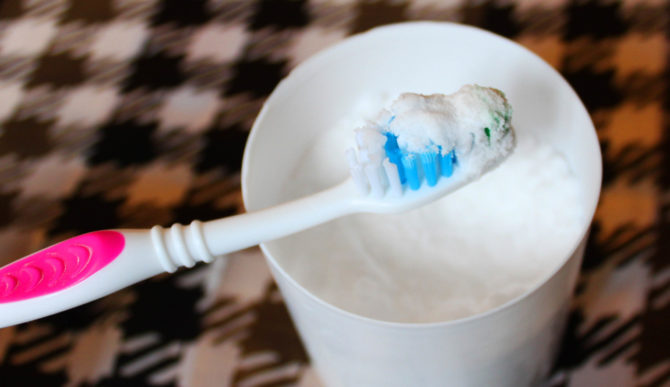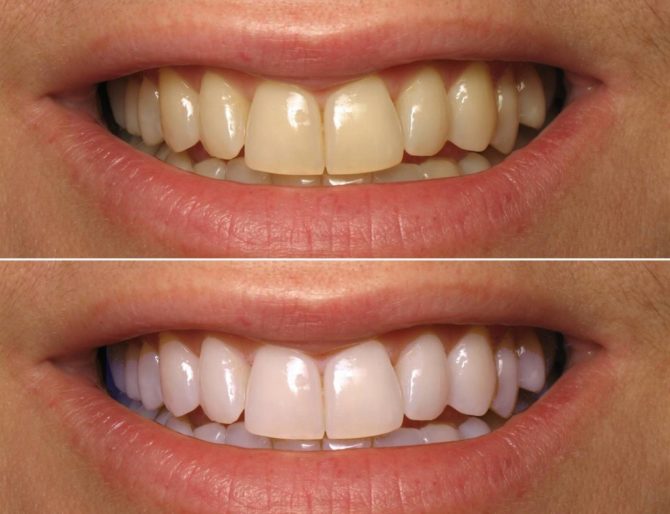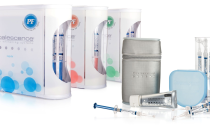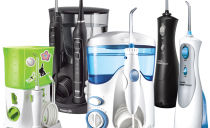How to whiten teeth with soda at home
By nature, tooth enamel has a yellowish tint, so it’s impossible to boast a snow-white smile without intervention. Clinic procedures and special strips are not cheap, and folk remedies come to the rescue. It’s easy to whiten teeth with soda at home.
Content
The principle of soda
The natural color of the enamel depends on the shade of dentin - the inside of the tooth. Its structure is porous, and any dyes are practically absorbed into the surface. The deeper the pigments penetrate, the darker the crown looks, and the harder it is to get rid of the darkening.
Various factors can provoke a discoloration of the surface of the teeth, most often affect:
- violation of hygiene rules;
- excess fluoride water;
- tissue demineralization due to caries;
- smoking;
- regular use of strong coffee or tea;
- food colorings;
- tetracycline drugs.
The use of folk methods and whitening pastes will be effective only if the teeth are not damaged and color changes are temporary.
In fact, soda consists of many small crystals, and the whitening effect is achieved due to the abrasive effect on the surface of tooth enamel. With the help of mechanical action, all plaque and the remains of the coloring pigment are removed from the tooth. Baking soda also provides disinfecting effect, for some time, the weakening effect of bacteria.
There is a negative side to the process: when bleaching with soda, not only harmful plaque is removed. Together with it, the thinnest layer of enamel is removed, which negatively affects the condition of the tooth and thins it. Too aggressive mechanical action will lead to micro-scratches, which will become a haven for the growth of bacteria.
The benefits of teeth whitening with soda include accessibility and quick results. The disadvantages are the risk of allergic reactions, the possibility of damage to the mucous membrane or gums.
Contraindications
Only adults can carry out bleaching: for children under twelve, such an effect will not work for the benefit. The procedure is not recommended for pregnant women and women who are breastfeeding. Also, unambiguous contraindications include:
- gum disease;
- diseases of the oral cavity;
- sores or sores on the mucosa;
- thinned tooth enamel;
- cracks or defects;
- lack of calcium;
- allergy.
It is preliminary recommended to visit a doctor and inform him of his plans. The dentist must evaluate the condition of the oral cavity. If any contraindications are found, bleaching with soda will have to be postponed.
Training
To reduce the harmful effects on enamel, the procedure can only be carried out after a certain preparation. So, fluoride enamel recommended. Vitamin-mineral complexes and special toothpastes will help in this. You need to use them twice a day for two weeks.
It is useful to add foods rich in calcium and fluoride to your diet. These include:
- greenery;
- cottage cheese;
- green tea;
- sour milk;
- grapefruit;
- apples
- potatoes;
- seafood;
- oatmeal;
- buckwheat grain.
Gums also need to be strengthened: special mouth rinses will help.Preparation begins at least a month before the planned teeth whitening with soda at home.
How to bleach
The easiest way to whiten is to use pure soda. To do this, moisten the brush with water, scoop up a little powder and perform normal brushing.
Only an ultra-soft toothbrush can be used: otherwise the risk of damage to the enamel is too high.
Another option is to make a kind of toothpaste. To do this, water and soda are mixed for teeth whitening in the proportions of 1: 2. Everything is thoroughly mixed until a homogeneous slurry is formed, which is applied to the brush.
Whitening is carried out once a week. The effect is noticeable after the first procedure. The number of such cleanings is determined by a person independently, but you should not be too zealous.
For brittle enamel, there is a more gentle way to whiten teeth with soda. The main rule is to apply the powder to a wet bandage, a gauze swab or a cotton swab. Teeth need to be processed for approximately 2-3 minutes with soft circular movements. After the procedure, rinse your mouth thoroughly.
Soda with lemon
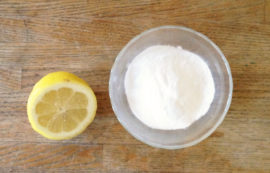 Before using baking soda with lemon, you must make sure that there are no diseases in the oral cavity. Citric acid itself does not particularly affect enamel, but with its help you can enhance the effect of soda itself.
Before using baking soda with lemon, you must make sure that there are no diseases in the oral cavity. Citric acid itself does not particularly affect enamel, but with its help you can enhance the effect of soda itself.
Simply put the powder on the brush, add a few drops of lemon juice on top and brush your teeth in the usual way.
Soda and peroxide
Soda and hydrogen peroxide have a double effect: each component is a bleach. It is simple to prepare the mixture: a small amount of powder is diluted with a 3% peroxide solution and mixed until a homogeneous gruel is present. Within a couple of minutes, you need to brush your teeth with the resulting mixture.
You can spend no more than ten procedures per year.
Soda and Vinegar
The use of apple cider vinegar can be made with or without soda. It has a positive effect on the oral cavity when rinsing: for this, the product is diluted with water in proportions of 1: 3. For cleaning, the components are mixed so that a homogeneous mass is obtained. It is applied to the tooth surface. The exposure time is from five to ten minutes.
After that, everything is washed off with warm water and normal cleaning is performed.
Strawberry Soda
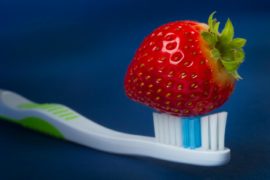 With strawberries, the teeth whitening process with soda will taste good. In addition to the powder, you need a small amount of berries - 2-3 pieces. They knead with a fork until mashed, sprinkled with soda, everything is thoroughly mixed. Using a brush, the product is applied to the teeth. The mixture is left for five minutes, then rinsed with warm water.
With strawberries, the teeth whitening process with soda will taste good. In addition to the powder, you need a small amount of berries - 2-3 pieces. They knead with a fork until mashed, sprinkled with soda, everything is thoroughly mixed. Using a brush, the product is applied to the teeth. The mixture is left for five minutes, then rinsed with warm water.
Soda, lemon and peroxide
The main thing in this recipe is to observe certain proportions of ingredients. It is necessary:
- 0.5 teaspoon of lemon juice;
- 0.5 teaspoon of soda;
- 5 drops of a 3% hydrogen peroxide solution.
Everything is carefully altered, no toothbrush. The finished product is applied to each tooth so that there is no contact with the gums: the mixture can cause irritation and damage the mucous membrane. After 3-5 minutes, everything is washed off with warm boiled water.
While whitening teeth with soda, gums must be protected. So that the product does not fall on them, you can make a mask of foil, which is worn only on enamel.
Proper whitening at home
Before you whiten your teeth with soda, you need to familiarize yourself with some rules for conducting such procedures at home. This will help to prevent damage to the teeth or soft tissues of the oral cavity.
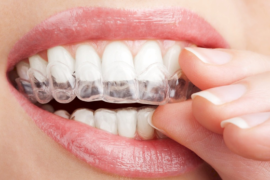 The maximum duration of the procedure is five minutes. You need to start with less time, gradually increasing it.
The maximum duration of the procedure is five minutes. You need to start with less time, gradually increasing it.- Safe for tooth enamel frequency - once a week. With increased sensitivity, the intervals between whitening should be 10-14 days. Too frequent a process will only harm the crowns.
- During cleaning, do not put too much pressure on the brush: soda teeth whiten somewhat aggressively, and with intense exposure, abrasive particles will simply scratch the enamel. The surface should be treated delicately, as if wiping it.
- Before bleaching teeth with soda, they need to be strengthened. If this is not done, they can become very sensitive and give an acute reaction to hot and cold. In this case, the intervals between the procedures are doubled.
The method is forbidden to people who wear a brace or brackets: soda is quite aggressive and dissolves orthodontic glue. Whitening may result in loss of dentures.
When carrying out the procedure at home, you need to follow all safety rules. If the sensitivity of the teeth becomes too strong, and the gums begin to bleed, bleaching must be stopped.
The whitening effect is noticeable after the first procedure, so you should not chase the speed. Regular but rare treatments are a more gentle option for enamel. Excessive zeal in this matter threatens irreversible consequences not only for the teeth, but also for the mucous membrane of the mouth and gums.
After whitening care
During the first days after the procedure, the enamel becomes as sensitive as possible. Protection against pigments contained in food and aggressive substances is significantly reduced. Dentists recommend that you follow the same rules as after professional cleaning in the clinic. Any foods that might stain your teeth are prohibited.. These include:
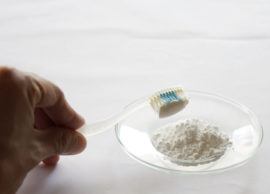 Red wine;
Red wine;- bright sauces;
- coffee;
- strong black tea;
- colored sparkling water;
- fruit drinks;
- red or orange fruits, vegetables and berries;
- sweets with dyes;
- chocolate.
It is also advisable to give up cigarettes. If you can’t completely exclude them, after each smoking you need to rinse your mouth with a special rinse or plain water to wash off the remnants of the tar. On the enamel weakened after bleaching, the coloring pigments of tobacco settle many times faster, and the process of disposal will become more complicated.
Particular attention is paid to oral hygiene. Need to use soft toothbrush and paste without abrasive particles. Additionally, rinse conditioner and dental floss are purchased. It is advisable to brush your teeth not only in the morning and in the evening, but also after each meal. If this is not possible, cleaning is replaced by rinsing.
Before you whiten your teeth with soda at home, you should definitely visit a dentist. In the absence of contraindications and the correct approach to the procedure, you can achieve a good effect in a short time. In the future, you just need to maintain oral hygiene, repeating the procedure as necessary.

